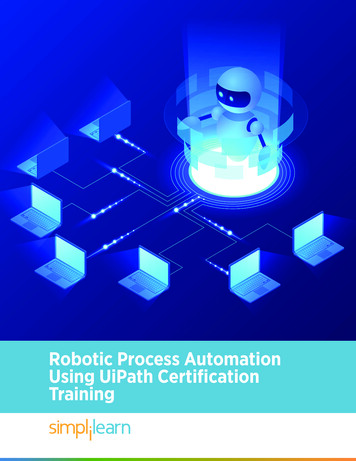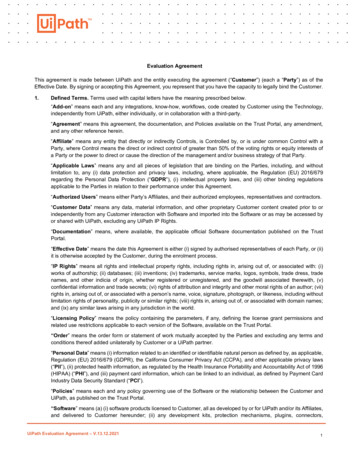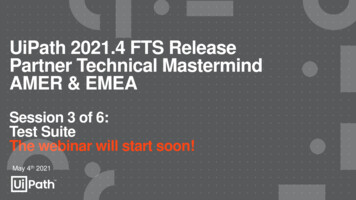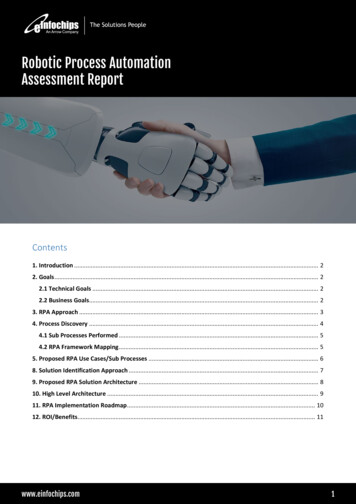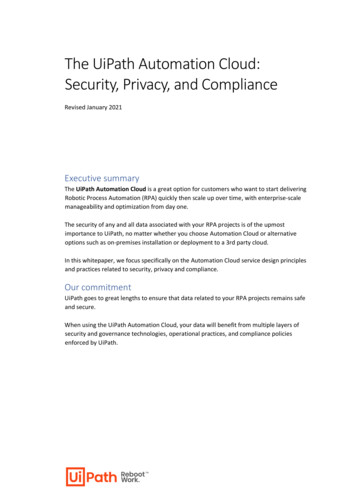
Transcription
The UiPath Automation Cloud:Security, Privacy, and ComplianceRevised January 2021Executive summaryThe UiPath Automation Cloud is a great option for customers who want to start deliveringRobotic Process Automation (RPA) quickly then scale up over time, with enterprise-scalemanageability and optimization from day one.The security of any and all data associated with your RPA projects is of the upmostimportance to UiPath, no matter whether you choose Automation Cloud or alternativeoptions such as on-premises installation or deployment to a 3rd party cloud.In this whitepaper, we focus specifically on the Automation Cloud service design principlesand practices related to security, privacy and compliance.Our commitmentUiPath goes to great lengths to ensure that data related to your RPA projects remains safeand secure.When using the UiPath Automation Cloud, your data will benefit from multiple layers ofsecurity and governance technologies, operational practices, and compliance policiesenforced by UiPath.
UiPath Automation Cloud: designThe UiPath Automation Cloud is composed of multiple independent services, such as CloudPortal, Tenant Management Service, Licensing Service, and Orchestrator, among others.To provide a seamless experience, we work hard to abstract these details from the end user.We offer these services through a common front-end called the UiPath Cloud Portal.Before delving into the details surrounding UiPath’s approach to security, privacy, andcompliance, we first need to provide some background about the key services in theAutomation Cloud.
Cloud PortalCloud Portal serves as the first entry point for our customers to create an account for theirorganization. Customers can also: Invite additional users and manage their roles and permissionsRequest licenses for robotsSet up orchestrator service instance(s) for their development, testing, andproduction needsOrchestratorThe UiPath core platform’s server-side component is known as Orchestrator. It allowscustomers to manage their entire RPA infrastructure from one central control plane. If youare a current on-premises or 3rd party cloud customer, you are familiar with the functionalityand interface.We now provide a seamless experience for existing and new customers by integratingUiPath Orchestrator into the heart of our cloud offering.There are two variations of the Automation Cloud. Customers who choose the free UiPathAutomation Cloud for community receive a unique tenant on an instance of Orchestratorshared with other customers. Customers who choose the more feature-rich UiPathAutomation Cloud for enterprise can have multiple tenants within their single enterprisecloud instance, enabling them to manage multiple RPA environments from within theircloud. Although this instance is also shared with other paying customers, strict virtualseparation ensures that no customer ever has access to any other customer’s data orconfiguration.If you would like to see this experience for yourself, we invite you to try this out at any timewith the trials at UiPath.com.Additional documentation on Orchestrator can be found on our website.AI CenterUiPath’s cognitive services platform is called AI Center. AI Center allows Automation Cloudusers to deploy and manage machine learning models within the Automation Cloud. RPAdevelopers can easily integrate their RPA automations with the models to extend a robot’sability to perform complex tasks.Additional documentation on AI Center can be found on our website.Tenant Management ServiceEach customer is represented as a tenant in the UiPath Automation Cloud. Each tenant canmap their organization’s internal structure and corresponding users using the tenant
management capabilities. This offers customers the flexibility needed for governance of RPAprojects.Tenant Management Service is decoupled from our portal and offers isolation in thebackend while delivering a seamless user experience to the customer.Licensing ServiceThe underlying mechanism that keeps track of licenses issued, activation status for robots,and run-time checks on usage is packaged as an independent service that interfaces withCloud Portal, Orchestrator and the other services.Identity ServiceUser identity is managed by a central service in the UiPath Automation Cloud. Users log intothe system using either an external identity provider or through a UiPath Automation Cloudaccount. The UiPath identity service then combines the externally managed user identitywith UiPath user and tenant information. This internal identity is used to identify users whenthey enter the UiPath Automation Cloud and to identify users between the components.Service-design principlesAll of the above services are packaged together as UiPath Automation Cloud and deliveredvia a Software-as-a-Service (SaaS) model that’s built and hosted in Microsoft Azure. They alluse core Azure services, including compute, storage, networking, SQL database, appconfiguration, secret storage in Key Vault, and identity and access management.This allows us to focus on the unique aspects of running UiPath’s services while takingadvantage of, and building upon, Azure’s state-of-the-art capabilities in security, privacy,and compliance. We also utilize the industry certifications available through Azure.At UiPath, we share the responsibility of protecting your data with Azure, and strictly adhereto the guidance they publish.Data encryptionWe encrypt all customer data at rest in any data store that is part of our service. Forexample, we use transparent data encryption in SQL databases.All data is transmitted over protected channels, whether it travels over the Internet orwithin our internal service components.Identity and access managementWe support account creation in the Automation Cloud using a variety of identity serviceproviders, such as Google, Microsoft, and LinkedIn, as well as through native accounts. Postaccount creation, our services manage a given user’s access rights using applicationmanaged, role-based access control checks.
Our on-premises customers have long used Orchestrator’s roles-based account control(RBAC). With the introduction of tenant management to the Automation Cloud, we nowhave similar RBAC controls there to provide a seamless experience for our customers.Tenant data isolationData from each tenant is logically separated from others in our service so that we canenforce access and authorization controls for all tenants as they access data inside ourservice.Package integrityStarting with the 2019 fast-track release of our core platform, we added the ability to signpackages and workflows that are uploaded into Orchestrator. As an aside, AutomationCloud customers automatically receive the latest updates approximately every 2 weeks,meaning our Automation Cloud customers also get this new, additional protection.Customers can publish packages to the UiPath-managed Orchestrator service in theAutomation Cloud with confidence and not worry about package integrity andcorresponding business impact should a server-side compromise occur.PrivacyUiPath collects two categories of data from users to operate and improve UiPathAutomation Cloud Services:1. Customer data: Includes user-identifiable transactional and interactional data that weneed to operate the service and to manage your contract with UiPath2. System-generated logs: Includes service-usage data that may be aggregated and containpieces of customer dataFrom a GDPR standpoint, UiPath is considered a data processor. As such, we honor allobligations of a data processor by providing customers with full control over their data, inaccordance with the product architecture and implementation.We have ensured that we can export all your data for you, upon request. Should you closeyour account with the UiPath Automation Cloud, or otherwise request data deletion, wedelete that data from our systems after the requisite 30 day soft-delete period.We recommend our customers assess if their use of our Automation Cloud is in line withtheir privacy obligations. For more information about UiPath’s privacy statement, howUiPath processes your data when using online services, and GDPR commitments, please visitour privacy policy.Data residency and sovereigntyWe know our customers care deeply about data location. As of January 2021, we nowsupport five separate server regions, US, EU, Canada, Australia, and Japan.
Robot and business data associated with the UiPath Automation Cloud for community (thefree service) is stored in EU.Customers on the UiPath Automation Cloud for enterprise may choose the location of theirtenants, and robot and business data is then stored in each tenant’s region. By default, thelocation of services for enterprise cloud users is based on the location of the account: Japanfor Japanese customers, Canada for Canadian customers, Australia for Australian and NewZealand customers, US for North American (excluding Canada) customers, and the EU for therest of the world. Customers can also request at any time that one of more of their tenantsbe moved to a different region. We will serve all content, and store all robot and businessdata, from the region each tenant is hosted in. We may continue to add additional regionsas options for enterprise cloud customers as we see demand grow.Please note also that although data from robots and business data is kept, encrypted, withinthe tenant region, some account-related data such as account name, user lists, and licenseinformation may be replicated outside the region as part of normal operations.Security and compliance practicesUiPath addresses the following aspects of security and compliance in order to help preventbreaches and uphold the highest standards for data security, privacy, and availability:Systems hardeningUiPath Cloud Services use Azure's Platform-as-a-Service (PaaS) offering for much of itsinfrastructure. PaaS automatically provides regular updates for known securityvulnerabilities.Secure development life cycleUiPath security and development teams work hand in hand to address security threatsthroughout the development process of UiPath Automation Cloud.Teams perform threat modeling during service design. They adhere to design and code bestpractices and verify security in the final product using a multi-pronged approach thatleverages internally built tools, commercial static and dynamic analysis tools, internalpenetration testing, and external bug bounty programs.We also monitor vulnerabilities introduced in our code base through third-party libraries andminimize our dependency on these libraries and corresponding exposure. Because thesecurity landscape is continually changing, our teams stay current with the latest in bestpractices. We also enforce annual training requirements for all engineers and operationspersonnel working on the UiPath Automation Cloud.
Service and data availabilityEnsuring that the Automation Cloud services are available so you can access yourorganization’s assets is of the utmost importance to us. That is why we rely on Azure’sbackup mechanism and practice data recovery.We employ other fail-safes to help ensure availability. A malicious distributed denial-ofservice (DDoS) attack, for example, could affect UiPath Automation Cloud serviceavailability. Azure has a DDoS defense system that helps prevent attacks against our service.It uses standard detection and mitigation techniques such as SYN cookies, rate limiting, andconnection limits.The system is designed not only to withstand attacks from the outside, but also from withinAzure.Live site testingWe emulate adversarial tactics on our services and underlying infrastructure using internalred teams.The goal is to identify real-world vulnerabilities, configuration errors, and other security gapsin a controlled manner so that we can test the effectiveness of our prevention, detection,and response capabilities.Security incident responseWe strive to minimize the attack surface of our services and go to great lengths to reducethe probability of a data breach ever occurring. Nevertheless, security incidents can stillhappen.In the event of a breach, we use security response plans to minimize data leakage, loss, orcorruption. We provide transparency to our customers throughout the incident. Our 24x7SRE and Security team is always on hand to rapidly identify the issue and engage thenecessary development team resources to contain the impact of the incident.Once the team has contained an issue, our security incident management process continuesas we identify the root cause and track the necessary changes to ensure we prevent similarissues in the future.Production access controlWe maintain strict control over who has access to our production environment andcustomer data.Access is only granted at the level of least privilege required and only after properjustifications are provided and verified. If a team member needs access to resolve an urgent
issue or deploy a configuration change, they must apply for "just in time" access to theproduction service.Access is revoked as soon as the situation is resolved. Access requests and approvals aretracked. If the username and password for one of our developers or operation staff wereever stolen, data is still protected because we use two-factor authentication for allproduction system access.Secrets ManagementSecrets that we use to manage and maintain the service, such as encryption keys, aremanaged, stored, and transmitted securely through the Azure Management Portal.All secrets are rotated on a regular cadence and can be rotated on-demand if there is asecurity event.Security and Compliance CertificationsUiPath has obtained the ISO 27001:2013 and Veracode continuous certifications thatspecifically include and name the Automation Cloud (under its former name, the “UiPathCloud Platform”) as well as other UiPath products. They can be seen on this page forreference. UiPath has also obtained a SOC 2 type 1 report that can be shared withcustomers and prospects under NDA. We are working towards completing the SOC 2 type 2certification next in early 2021, with additional certifications to follow. Additionally, yourUiPath team can assist with any security architecture or capability questions not covered inthis whitepaper.Summary overviewThe UiPath Automation Cloud is committed to upholding the highest standards of datasecurity, privacy, and compliance.We live up to this mission through a combination of platform design, service-designprinciples, and security and compliance best practices.The culmination of these efforts is an automation cloud that is as secure and reliable as it iscost-effective and scalable.If you have questions or concerns about our Automation Cloud security, privacy orcompliance approach, your UiPath representative can assist in getting you any furtherinformation you may need from our team.Thank you for considering UiPath and the UiPath Automation Cloud!About UiPathHeadquartered in New York City, UiPath is leading the “automation first” era – championing one robot for everyperson, delivering free and open training and collaboration and enabling robots to learn new skills through AI
and machine learning. Led by a commitment to bring digital era skills to more than a million people, thecompany’s enterprise Robotic Process Automation (RPA) platform has already automated millions of repetitive,mind-numbing tasks for business and government organizations all over the world, improving productivity,customer experience and employee job satisfaction.Recently named by Comparably as the 6th happiest place to work and recognized for having the 11th bestcompany culture among large businesses, UiPath is one of the fastest growing and highest-valued AI enterprisesoftware companies worldwide. 2005–2021 UiPath. For informational purposes only. All rights reserved.
The UiPath Automation Cloud is composed of multiple independent services, such as Cloud Portal, Tenant Management Service, Licensing Service, and Orchestrator, among others. To provide a seamless experience, we work hard to abstract these details from the end user. We offer these services through a common front-end called the UiPath Cloud Portal.


